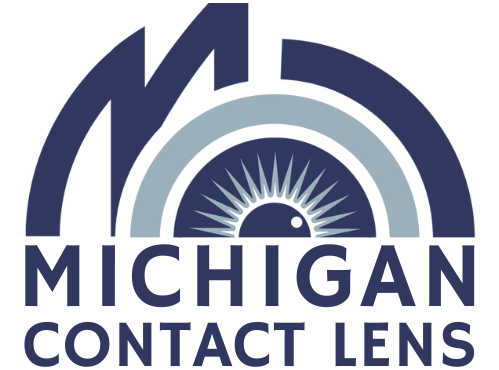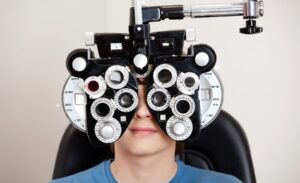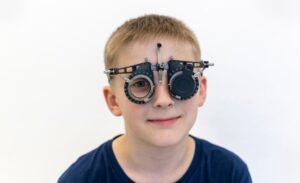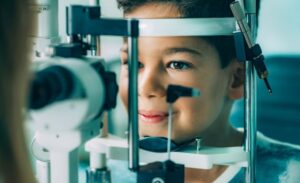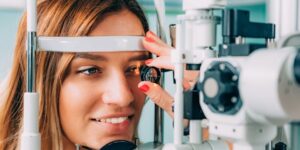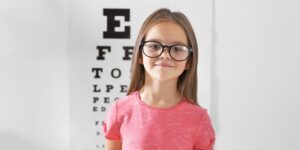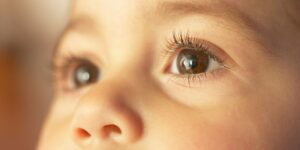Understanding Myopia Control
To effectively address myopia in children, it’s important for parents to understand the concept of myopia control. This section will provide an overview of what myopia is, emphasize the importance of myopia control, and explore various methods used for myopia control Drops.
What is Myopia?
Myopia, commonly known as nearsightedness, is a refractive error that causes distant objects to appear blurry while close-up objects remain clear. It occurs when the eyeball is slightly longer than normal or when the cornea is too curved, causing light entering the eye to focus in front of the retina instead of directly on it.
Myopia typically develops during childhood and can progress over time. If left uncontrolled, it may result in high levels of myopia, increasing the risk of eye conditions such as retinal detachment, glaucoma, and macular degeneration.
The Importance of Myopia Control
The increasing prevalence of myopia worldwide has highlighted the importance of implementing effective myopia control strategies. Myopia not only affects visual clarity but also impacts a child’s overall quality of life and academic performance. By actively managing myopia, parents can help slow down the progression of the condition and potentially reduce the risk of associated eye health complications.
Various Methods of Myopia Control
There are several methods available for myopia control, each with its own unique approaches and goals. These methods aim to slow down the progression of myopia and reduce the degree of nearsightedness over time. Some common methods include:
- Myopia control contact lenses: Specially designed contact lenses that reshape the cornea and provide clear vision while also slowing down the progression of myopia. For more information, you can refer to our article on myopia control contact lenses.
- Myopia control lenses: Eyeglass lenses that incorporate specific optical designs to reduce the strain on the eyes and slow down the progression of myopia. Our article on myopia control lenses provides more details on this option.
- Pharmaceutical interventions: Myopia control drops, such as atropine or low-dose antimuscarinic eye drops, may be prescribed to children to slow down the progression of myopia. These drops help relax the eye’s focusing mechanism and reduce eye elongation. More information on myopia control drops can be found in our article on myopia control drops.
- Orthokeratology: Also known as Ortho-K, this method involves wearing specialized contact lenses overnight to temporarily reshape the cornea and provide clear vision during the day. Orthokeratology is covered in detail in our article on myopia control methods.
- Behavioral modifications: Encouraging children to spend more time outdoors and limiting screen time may help reduce the progression of myopia. Studies have shown that increased outdoor activities can have a protective effect against myopia development.
It’s important to consult with an eye care professional to determine the most suitable myopia control method for your child. They can assess your child’s specific needs and recommend the best approach based on their age, lifestyle, and the severity of myopia. Our article on myopia control provides more comprehensive information on managing myopia in children.
By understanding what myopia is, recognizing the significance of myopia control, and exploring the various methods available, parents can make informed decisions regarding their child’s eye health and contribute to the long-term well-being of their vision.
Exploring Myopia Control Drops
For parents concerned about their children’s myopia progression, myopia control drops may be a potential solution worth considering. In this section, we will delve into what myopia control drops are, how they work, and the different types available.
What are Myopia Control Drops?
Myopia control drops, also known as ophthalmic atropine drops, are a type of medication that can help slow down the progression of myopia in children. These drops are typically prescribed by an eye care professional and are applied directly to the eyes.
The active ingredient in myopia control drops is atropine, a medication that dilates the pupils and temporarily paralyzes the focusing mechanism of the eyes. By doing so, it helps to reduce the strain that contributes to myopia progression.
How Do Myopia Control Drops Work?
Myopia control drops work by relaxing the focusing muscles in the eyes, which helps regulate the growth of the eyeball. In individuals with myopia, the eyeball tends to elongate, leading to nearsightedness. By using myopia control drops, the elongation of the eyeball can be slowed down, reducing the progression of myopia over time.
It’s important to note that myopia control drops do not cure myopia but rather help manage its progression. Regular use of these drops, in conjunction with other myopia control methods, may be recommended for optimal results. For more information on different myopia control methods, you can refer to our article on myopia control methods.
Different Types of Myopia Control Drops
There are different concentrations of atropine used in myopia control drops. The most commonly prescribed concentrations include 0.01%, 0.025%, and 0.05%. The choice of concentration depends on various factors such as the severity of myopia, the age of the child, and the recommendations of the eye care professional.
To better understand the different concentrations and their effectiveness, refer to the table below:
| Atropine Concentration | Effectiveness |
|---|---|
| 0.01% | Shown to effectively slow myopia progression with minimal side effects. |
| 0.025% | Provides a balance between myopia control and potential side effects. |
| 0.05% | Can effectively slow down myopia progression, but may have more noticeable side effects. |
It’s important to consult with an eye care professional to determine the most suitable concentration of myopia control drops for your child. They will consider various factors, including the child’s age and overall eye health, to make an informed recommendation.
Understanding the basics of myopia control drops is crucial for parents seeking options to manage their child’s myopia progression. By consulting an eye care professional and discussing the different types of myopia control drops available, parents can make an informed decision about the most appropriate course of action.
Effectiveness and Safety
When considering myopia control drops as a treatment option for your child’s myopia, it is important to understand both their effectiveness and safety. Let’s explore these aspects in detail.
Effectiveness of Myopia Control Drops
Myopia control drops, also known as ophthalmic atropine drops, have been shown to be effective in slowing down the progression of myopia in children. Atropine, the active ingredient in these drops, works by temporarily relaxing the focusing muscles in the eye, which helps to reduce the development of myopia.
Research studies have demonstrated that atropine eye drops can effectively slow down myopia progression by approximately 50% to 60% over a period of two years. It is important to note that the exact effectiveness may vary depending on factors such as the concentration of atropine used and the individual response of the child’s eyes.
Safety Considerations for Myopia Control Drops
While myopia control drops have proven to be effective, it is essential to consider their safety. Atropine, even at low concentrations, can cause temporary side effects such as sensitivity to light, blurred near vision, and difficulty focusing on nearby objects. However, it is important to note that these side effects are typically mild and transient.
To minimize the occurrence of side effects, eye care professionals often prescribe low-concentration atropine drops, such as 0.01% or 0.025%. These lower concentrations have been found to be effective in controlling myopia progression while reducing the likelihood of significant side effects.
It is crucial to consult an eye care professional who specializes in myopia control to determine the most appropriate concentration of atropine for your child. They will consider various factors such as the severity of myopia, age, and individual response to treatment.
Regular monitoring and follow-up visits with the eye care professional are essential to assess the effectiveness of myopia control drops and identify any potential side effects. If you have any concerns or notice any changes in your child’s vision or comfort while using the drops, it is important to communicate with your eye care professional promptly.
By understanding the effectiveness and safety aspects of myopia control drops, you can make an informed decision in consultation with your eye care professional. They will guide you through the process, address any concerns you may have, and ensure the best possible outcome for your child’s myopia control journey.
Factors to Consider
When considering the use of myopia control drops for your child, there are several important factors to take into account. These factors can help guide you in making an informed decision and ensuring the best possible outcome for your child’s eye health. Consider the following:
Age and Suitability
The age and suitability of your child is an important consideration when it comes to myopia control drops. While myopia control drops can be effective for children of various ages, it is essential to consult with an eye care professional to determine if they are appropriate for your child. The eye care professional will consider factors such as your child’s age, the progression of their myopia, and their overall eye health in determining the suitability of myopia control drops.
Compliance and Application
Compliance and proper application of myopia control drops are crucial for their effectiveness. It’s important to ensure that your child can follow the recommended dosage and application instructions provided by the eye care professional. This may involve instilling the drops into the eyes at specific times of the day or following a particular schedule. Discussing the application process with your child and emphasizing the importance of compliance can help ensure the best results.
Monitoring and Follow-up
Regular monitoring and follow-up appointments with your eye care professional are essential when using myopia control drops. The eye care professional will evaluate the effectiveness of the drops and monitor your child’s myopia progression. This may involve regular eye examinations and measurements of their refractive error. By closely monitoring your child’s progress, any necessary adjustments to the treatment plan can be made in a timely manner.
To gain a comprehensive understanding of myopia control and explore other methods available, such as myopia control contact lenses and myopia control lenses, visit our articles on myopia control, myopia control contact lenses, and myopia control lenses.
By considering these factors, you can make an informed decision in consultation with your eye care professional regarding the use of myopia control drops for your child. Remember, the ultimate goal is to ensure the long-term eye health and well-being of your child, and regular communication with your eye care professional is crucial throughout the process.
Discussing with Your Eye Care Professional
When considering myopia control drops for your child, it is crucial to consult an experienced eye care professional. They can provide valuable guidance and help you make an informed decision about the best course of action. Here are the key steps to take when discussing myopia control drops with your eye care professional.
Consulting an Eye Care Professional
The first step is to schedule an appointment with an eye care professional who specializes in myopia control. They will conduct a comprehensive eye examination to assess your child’s eye health and determine the severity of their myopia. This examination may include tests such as visual acuity measurements, refraction tests, and an examination of the retina.
During the consultation, the eye care professional will explain the various myopia control options available, including myopia control drops. They will provide information about the benefits, risks, and potential outcomes associated with these drops.
Questions to Ask
To make the most of your consultation, it’s important to come prepared with a list of questions. Here are some questions you may consider asking:
- What are the specific benefits of myopia control drops? Understanding the potential advantages can help you make an informed decision about whether this treatment option is suitable for your child.
- What are the potential risks or side effects of myopia control drops? It’s important to be aware of any potential risks or side effects associated with these drops, as well as any measures that can be taken to minimize them.
- How do myopia control drops compare to other myopia control methods? Your eye care professional can help you understand how myopia control drops stack up against other methods, such as myopia control contact lenses, myopia control lenses, or myopia control exercises.
- What is the expected timeline for seeing results with myopia control drops? Understanding the potential timeframe for results can help manage expectations and determine if this treatment option aligns with your child’s needs.
- What is the cost of myopia control drops and is it covered by insurance? Financial considerations are important, so it’s essential to discuss the cost of myopia control drops and whether they are covered by insurance.
- What is the recommended follow-up schedule? Regular monitoring is crucial when using myopia control drops. Ask about the recommended frequency of follow-up visits and any additional steps you need to take to ensure the effectiveness of the treatment.
Making an Informed Decision
After discussing myopia control drops with your eye care professional and getting answers to your questions, you’ll be better equipped to make an informed decision. Consider factors such as the severity of your child’s myopia, their age and suitability for the treatment, and your own comfort level with the recommended approach.
Remember, myopia control drops are just one of the various methods of myopia control available. Collaborate closely with your eye care professional to determine the most appropriate option for your child’s specific needs. Their expertise and guidance will help you navigate the world of myopia control and ensure the best outcome for your child’s eye health.
